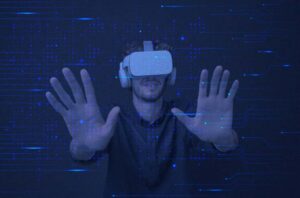Augmented Reality (AR) isn’t a novel concept. Its foundational principles trace back to the 1960s. However, the recent decade has witnessed a significant leap in its popularity and usage. This innovative technology integrates digital information into the user’s physical environment in real-time. Although it’s often associated with Virtual Reality (VR), AR has a broader spectrum encapsulating several facets. Let’s delve into the main types of Augmented Reality: superimposition-based AR, marker-based AR, computer vision-based AR, and Natural User Interface-based AR, offering a deeper understanding of their features and applications.
Superimposition-based Augmented Reality
Superimposition-based AR either partially or fully replaces the original view of an object with a newly augmented view of that same object. The overlaying of digital data creates an enhanced perception of reality, providing a unique, immersive experience to users. This type of AR requires object recognition to function effectively. For instance, in the healthcare sector, surgeons use this technology to superimpose a patient’s X-ray vision onto their body to carry out precision-based surgeries.
Marker-based Augmented Reality
Also known as Image Recognition or Recognition-based AR, Marker-based AR uses a camera and some type of visual marker, such as a QR/2D code, to produce a result when the marker is sensed by a reader. Popular apps like Snapchat use these markers to apply cheeky filters, bringing a fun, interactive digital experience to users.
Computer Vision-based Augmented Reality
Computer Vision-based AR uses algorithms and mathematical models to recognize and interpret surroundings. It doesn’t rely on markers as it can use the features of the environment to place digital content. Computer vision-based AR can recognize shapes, objects, and even create a depth map of the scene. This technology has the potential to transform industries like ecommerce, where it can provide customers with a virtual try-on experience.
Natural User Interface-based Augmented Reality (NUI)
Natural User Interface (NUI)-based AR is the most immersive and interactive form of AR. Its purpose is to create an interface that’s as natural to use as possible. It relies on commonly used human actions such as voice commands, body movements, and even eye-tracking to interact with digital content. Microsoft’s HoloLens is a perfect example of how NUI is making the user interaction more natural and intuitive.
The Historical Journey of Augmented Reality (AR)
The origins of Augmented Reality (AR) can be traced back to a research paper penned by Dr. Thomas Caudell and Dr. Myron Kruger in 1990, marking the birth of a new era in digital technology. The term ‘Augmented Reality’ was used to describe a technology that blends computer-generated enhancements into a user’s real-world view, thus augmenting their reality.
The process involves overlaying 3D images and objects onto the physical world, usually achieved through a camera connected to a computing device capable of generating realistic simulations. Manipulated via software applications, users could then immerse themselves in these augmented environments at their leisure. Essentially, this innovative technology grants users the ability to explore boundless, artificially constructed realities that extend beyond their immediate environment.
As the technology has evolved over the years, there are now multiple forms of AR, each with its unique characteristics and capabilities. Let’s delve deeper into these different classifications of Augmented Reality.
Superimposition-based Augmented Reality
Superimposition-based AR, as the name suggests, enhances the real world by superimposing virtual objects or overlays onto real-world objects. The resulting amalgamation provides a unique, immersive experience. This type of AR relies strongly on object recognition for effective functioning. For instance, in the medical field, doctors may use this type of AR to superimpose a patient’s X-rays onto their actual body to ensure greater precision during procedures.
Marker-based Augmented Reality
Also known as Image Recognition or Recognition-based AR, Marker-based AR utilizes a camera and a visual marker, such as a QR code, which, when detected by a reader, triggers a specific digital output. Well-known applications, such as Snapchat and Instagram, deploy marker-based AR to overlay filters and animations on user’s faces, thereby presenting a fun, interactive virtual experience.
Computer Vision-based Augmented Reality
Computer Vision-based AR makes use of intricate algorithms and mathematical models to identify and interpret the surrounding environment. Unreliant on specific markers, this type of AR uses environmental features to position digital content accurately and realistically. For example, this technology allows eCommerce platforms to offer customers a virtual try-on experience, enhancing customer engagement and satisfaction.
Natural User Interface-based Augmented Reality (NUI)
Arguably the most immersive type of AR, Natural User Interface (NUI)-based AR strives to build an interface that mimics natural human behavior. It employs common human actions like voice commands, body movements, and eye-tracking to interact with digital content, making the experience as intuitive as possible. Microsoft’s HoloLens is an excellent showcase for how NUI aims to make user interaction with augmented reality more natural and intuitive.
An In-depth Dive into the Varied Types of Augmented Reality (AR)
Augmented Reality, AR for short, blends digital information with the natural environment, enriching our perception of reality. This technology layers computer-generated enhancements over the user’s real-world view. Unlike Virtual Reality (VR), which creates a wholly artificial environment, AR enhances existing reality with additional information, interactivity, and visual content. AR applications span across diverse industries such as gaming, healthcare, and navigation. But to appreciate the full utility and potential of AR, it’s important to understand its different forms:
Marker-based AR
This type of Augmented Reality leverages physical markers, such as barcodes or QR codes, to trigger digitally augmented experiences. Marker-based AR is versatile, functioning across various devices and applications while offering enriched information or experiences over real-world views. For instance, envision being able to view historical data or price information of an object simply by pointing your AR-enabled device at it. A classic example of marker-based AR is the globally popular game, Pokémon Go!
Markerless AR
As the name indicates, Markerless AR doesn’t rely on marker recognition. Instead, it utilizes natural elements in the environment, such as a table or chair, as reference points to project images. Not requiring wearable devices reduces the chance of discomfort, making it a more accessible form of AR. However, this AR type is often limited to low-resolution imagery and indoor settings. Its main drawback is occlusion issues, where a physical object might block the digital projection.
Location-based AR
Location-based AR incorporates real-time information into the user’s environment. It’s commonly implemented in navigation and local search applications and is compatible with wearable devices like Google Glass. Some applications, like Matterport, combine location-based AR with other forms for a more immersive experience. Users can virtually explore an architectural model on their device while receiving location-specific information like nearby restaurants or gas stations.
Projection-based AR
Projection-based AR projects digital instructions directly into the user’s environment. For example, it could project assembly instructions for your newly purchased furniture right onto your living room floor. While beneficial in training simulations for careers such as firefighting or medical surgery, projection-based AR does have its limitations. It’s vulnerable to interference from external light sources and other electronic devices. Furthermore, it can be distracting, diverting the user’s attention from their surroundings.

Augmented Reality: Revolutionizing Various Industries and Applications
Augmented Reality, commonly referred to as AR, profoundly elevates our interaction with the physical world by overlaying digitally created perceptual data onto our real-world environments. Today, various forms of AR have permeated different industries, defining the future of technology-driven experiences. Here are some notable applications of AR:
- Digital Signage: Augmented Reality is used to overlay important product information onto real-world objects. This enhances customer engagement and simplifies decision-making in retail, without the need for additional hardware;
- AR Glasses: Devices like Google Glass project virtual data into the user’s field of view. They enable access to real-time information and entertainment while interacting with the environment, offering versatile applications like cooking assistance or workout data;
- VR Headsets: While not AR technology, VR headsets offer immersive experiences by transforming surroundings into a digital environment. Users can enjoy movies, games, and more in a 360-degree view by inserting their smartphones into these headsets;
- Virtual Tours: AR is used for virtual tours, providing previews of places like holiday destinations or real estate. This technology also enhances navigation experiences with AR-enabled map directions, aiding in efficient travel through unfamiliar areas.
Wrapping up
Augmented Reality (AR) has come a long way since its inception, bringing to life a dynamic blend of the physical and the digital world. With its diverse types such as video-based, sensor-based, audio-based, and mixed Reality, AR tailors unique experiences based on the end-use. Whether it’s animating video games with thrilling realism, imparting musical lessons with real-time feedback, or enriching mundane tasks like grocery shopping with informative overlays, AR holds the key to a technologically enhanced future. As we delve deeper into its potential, AR promises to redefine our interactions with the world, making the leap from simply being augmentations of reality to integral parts of our day-to-day life.


Average Rating